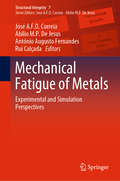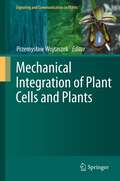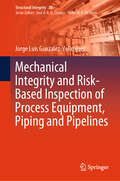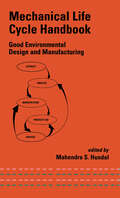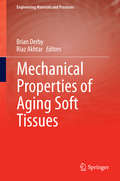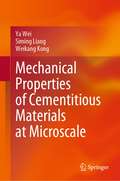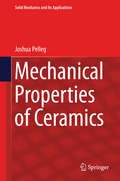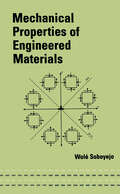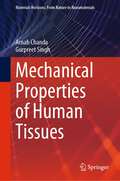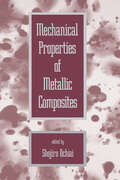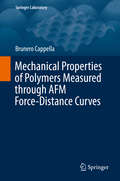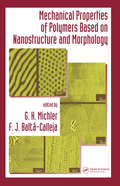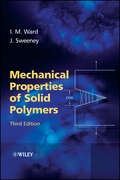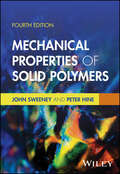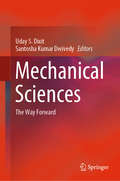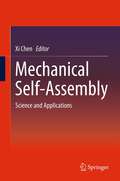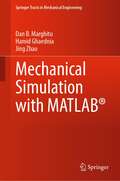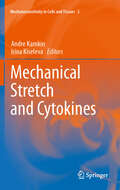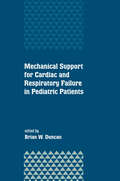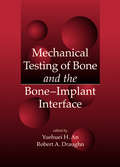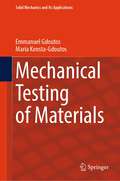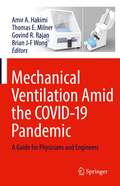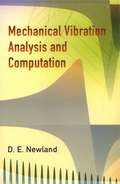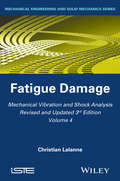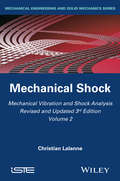- Table View
- List View
Mechanical Fatigue of Metals: Experimental and Simulation Perspectives (Structural Integrity #7)
by António Augusto Fernandes José A.F.O. Correia Abílio M.P. De Jesus Rui CalçadaThis volume contains the proceedings of the XIX International Colloquium on Mechanical Fatigue of Metals, held at the Faculty of Engineering of the University of Porto, Portugal, 5-7 September 2018. This International Colloquium facilitated and encouraged the exchange of knowledge and experiences among the different communities involved in both basic and applied research in the field of the fatigue of metals, looking at the problem of fatigue exploring analytical and numerical simulative approaches. Fatigue damage represents one of the most important types of damage to which structural materials are subjected in normal industrial services that can finally result in a sudden and unexpected abrupt fracture. Since metal alloys are still today the most used materials in designing the majority of components and structures able to carry the highest service loads, the study of the different aspects of metals fatigue attracts permanent attention of scientists, engineers and designers.
Mechanical Integration of Plant Cells and Plants
by Przemyslaw WojtaszekChemical reactions and interactions between molecules are commonly considered the basis of life, and thus the biochemical nature of cells and organisms is relatively well recognized. Research conducted in recent years, however, increasingly indicates that physical forces profoundly affect the functioning of life at all levels of its organization. To detect and to respond to such forces, plant cells and plants need to be structured mechanically. This volume focuses on mechanical aspects of plant life. It starts with a consideration of the mechanical integration of supracellular structures and mechanical properties of cellular building blocks to show how the structural integrity of plant cells is achieved and maintained during growth and development. The following chapters reveal how the functioning of integrated plant cells contributes to the mechanical integration of plants, and how the latter are able to detect physical stimuli and to reorganize their own cells in response to them. The mechanical aspects of plant responses to stresses are also presented. Finally, all these aspects are placed in an evolutionary context.
Mechanical Integrity and Risk-Based Inspection of Process Equipment, Piping and Pipelines (Structural Integrity #30)
by Jorge Luis Gonzalez-VelazquezThis book explores Mechanical Integrity (MI) and Risk-Based Inspection (RBI) methodologies, specifically tailored for professionals in chemical, petrochemical, and petroleum refining plants. It starts with foundational aspects of equipment and pipe design and manufacturing within the process industry, followed by an introduction to prevalent damage mechanisms in metal components during service. The book then delves into the general methodology for mechanical integrity analysis, covering remaining life estimation and methods for assessing common defects found in in-service components. It further introduces the principles and overall methodology of Risk-Based Inspection, detailing approaches for evaluating Probability of Failure and Consequences, along with the application of risk matrices to formulate Inspection-Based Risk (IBR) plans. Lastly, it directs attention to the practical implementation of MI and IBR methodologies for managing the integrity of pipelines transporting liquid and gaseous hydrocarbons, aligned with API codes and ASME standards, offering a comprehensive example illustrating the development of an integrity management plan for a real-life pipeline. Through this structured approach, professionals can gain actionable strategies and insights essential for ensuring the safety and reliability of industrial plants and pipelines.
Mechanical Life Cycle Handbook: Good Environmental Design and Manufacturing (Mechanical Engineering)
by Mahendra S. HundalExplains how Design for the Environment (SFE) and Life Cycle Engineering (LCE) processes may be integrated into business an dmanufacturing practices. Examines major environmental laws and regulations in the U.S. and Europe, qualitative and quantitative analyses of ""green design"" decision variables, and heuristic search programs for a proactive future in ecological improvement.
Mechanical Properties of Aging Soft Tissues
by Brian Derby Riaz AkhtarExploring the structure and mechanics of aging soft tissues, this edited volume presents authoritative reviews from leading experts on a range of tissues including skin, tendons, vasculature and plantar soft tissues. It provides an overview of in vivo and in vitro measurement techniques including state-of-the-art methodologies, as well as focusing on the structural changes that occur within the main components of these tissues resulting in detrimental mechanical property changes. It also highlights the current challenges of this field, and offers an insight into future developments. Age-related changes in the mechanical properties of soft tissues have a profound effect on human morbidity and mortality, and with changing global demographics, there is growing interest in this area. There has been increasing interest in robustly characterizing these mechanical changes to develop structure-property relationships, and growing awareness of the need for enhanced predictive models for computational simulations. This book seeks to address the challenges involved in applying these engineering techniques to reliably characterize these tissues. Focusing on a wide range of tissues and presenting cutting-edge techniques, this book provides an invaluable reference to academics and researchers in a range of disciplines including biomechanics, materials science, tissue engineering, life sciences and biomedicine.
Mechanical Properties of Cementitious Materials at Microscale
by Ya Wei Siming Liang Weikang KongThis book provides information on characterizing the microstructure and mechanical properties of cementitious materials at microscale. Specifically, with the intention to provide the methods of preparing the samples for the micro-scale mechanical testing, to address the techniques for measuring and analyzing the elastic modulus, the stiffness, and the fracture toughness of cementitious materials at micro scale by instrumented indentation, to describe a method for measuring and interpreting creep behavior of cementitious materials at micro scale, and to demonstrate the homogenization method for obtaining the mechanical properties of cementitious materials across scales. The information in this book is helpful to a wide readership in the field of civil engineering and materials science working with cementitious materials and other composite materials.
Mechanical Properties of Ceramics
by Joshua PellegThis book discusses the mechanical properties of ceramics and aims to provide both a solid background for undergraduate students, as well as serving as a text to bring practicing engineers up to date with the latest developments in this topic so they can use and apply these to their actual engineering work. Generally, ceramics are made by moistening a mixture of clays, casting it into desired shapes and then firing it to a high temperature, a process known as 'vitrification'. The relatively late development of metallurgy was contingent on the availability of ceramics and the know-how to mold them into the appropriate forms. Because of the characteristics of ceramics, they offer great advantages over metals in specific applications in which hardness, wear resistance and chemical stability at high temperatures are essential. Clearly, modern ceramics manufacturing has come a long way from the early clay-processing fabrication method, and the last two decades have seen the development of sophisticated techniques to produce a large variety of ceramic material. The chapters of this volume are ordered to help students with their laboratory experiments and guide their observations in parallel with lectures based on the current text. Thus, the first chapter is devoted to mechanical testing A chapter of ductile and superplastic ceramic is added to emphasize their role in modern ceramics (chapter 2). These are followed by the theoretical basis of the subject. Various aspects of the mechanical properties are discussed in the following chapters, among them, strengthening mechanisms, time dependent and cyclic deformation of ceramics. Many practical illustrations are provided representing various observations encountered in actual ceramic-structures of particularly technical significance. A comprehensive list of references at the end of each chapter is included in this textbook to provide a broad basis for further studying the subject The work also contains a unique chapter on a topic not discussed in other textbooks on ceramics concerning nanosized ceramics. This work will also be useful as a reference for materials scientists, not only to those who specialize in ceramics.
Mechanical Properties of Engineered Materials
by Wole SoboyejoFeaturing in-depth discussions on tensile and compressive properties, shear properties, strength, hardness, environmental effects, and creep crack growth, "Mechanical Properties of Engineered Materials" considers computation of principal stresses and strains, mechanical testing, plasticity in ceramics, metals, intermetallics, and polymers, materials selection for thermal shock resistance, the analysis of failure mechanisms such as fatigue, fracture, and creep, and fatigue life prediction. It is a top-shelf reference for professionals and students in materials, chemical, mechanical, corrosion, industrial, civil, and maintenance engineering; and surface chemistry.
Mechanical Properties of Human Tissues (Materials Horizons: From Nature to Nanomaterials)
by Gurpreet Singh Arnab ChandaThis monograph brings forth biomechanical research methods and outcomes on human tissue experiments such as those of the brain and the heart under a single umbrella. Different mechanical characterization techniques employed in human tissue property estimation are presented in detail. The contents also focus on a hyperelastic constitutive model (e.g., Mooney-Rivlin, Ogden) for both isotropic and anisotropic tissue characterization. It also discusses energy dissipation in soft tissues and associated viscoelasticity. Human tissues, including skin, muscles, connective tissues, and tissues in all functional organs are listed and their mechanical properties are presented in detail. These tissue properties are indispensable for computational modeling of biological systems, validation of biomechanical tissue testing, medical simulation through development of artificial phantoms and surrogates, and testing of medical devices and interventions. This book will serve as a key reference for research in tissue engineering & biomedical engineering, medical simulation, biomechanics, finite element modeling of biological systems, biomaterials, biotechnology, implant and medical device development, and healthcare wearables.
Mechanical Properties of Metallic Composites (Materials Engineering)
by Shojiro OchiaiProvides coverage of dispersion-hardened and fibre-reinforced alloys, addressing principal mechanisms, processing and applications. Mechanical behaviour based on dislocation theory and elastic-plastic mechanics is dealt with and data on advanced composites are provided.
Mechanical Properties of Polymers Measured through AFM Force-Distance Curves
by Brunero CappellaThis Springer Laboratory volume is a practical guide for scientists and students dealing with the measurement of mechanical properties of polymers at the nanoscale through AFM force-distance curves. In the first part of the book the reader will find a theoretical introduction about atomic force microscopy, focused on force-distance curves, and mechanical properties of polymers. The discussion of several practical issues concerning the acquisition and the interpretation of force-distance curves will help scientists starting to employ this technique. The second part of the book deals with the practical measurement of mechanical properties of polymers by means of AFM force-distance curves. Several "hands-on" examples are illustrated in a very detailed manner, with particular attention to the sample preparation, data analysis, and typical artefacts. This section gives a complete overview about the qualitative characterization and quantitative determination of the mechanical properties of homogeneous polymer samples, polymer brushes, polymer thin films, confined polymer samples, model blends and microstructured polymer blends through AFM force-distance curves. The book also introduces to new approaches and measurement techniques, like creep compliance and force modulation measurements, pointing out approximations, limitations and issues requiring further confirmation.
Mechanical Properties of Polymers based on Nanostructure and Morphology
by G. H. Michler F. J. Baltá-CallejaThe improvement of strength and durability in polymers has implications relevant to industrial, medical, and household applications. Enhanced by the improved knowledge of the interactions between complex hierarchical structures and functional requirements, Mechanical Properties of Polymers Based on Nanostructure and Morphology focuses on new polyme
Mechanical Properties of Solid Polymers
by I. M. Ward J. SweeneyProviding an updated and comprehensive account of the properties of solid polymers, the book covers all aspects of mechanical behaviour. This includes finite elastic behavior, linear viscoelasticity and mechanical relaxations, mechanical anisotropy, non-linear viscoelasicity, yield behavior and fracture. New to this edition is coverage of polymer nanocomposites, and molecular interpretations of yield, e. g. Bowden, Young, and Argon. The book begins by focusing on the structure of polymers, including their chemical composition and physical structure. It goes on to discuss the mechanical properties and behaviour of polymers, the statistical molecular theories of the rubber-like state and describes aspects of linear viscoelastic behaviour, its measurement, and experimental studies. Later chapters cover composites and experimental behaviour, relaxation transitions, stress and yielding. The book concludes with a discussion of breaking phenomena.
Mechanical Properties of Solid Polymers
by John Sweeney Peter HineThe latest edition of the definitive guide on the mechanical behaviors of polymers In the newly revised fourth edition of Mechanical Properties of Solid Polymers, a team of distinguished researchers delivers an up-to-date discussion of all aspects of the mechanical behavior of solid polymers. The book explores finite elastic behavior, linear viscoelasticity, mechanical relaxations, mechanical anisotropy, non-linear viscoelasticity, yield behavior, and fracture. The authors emphasize biopolymers – as opposed to petrochemical-based polymers – and incorporate a great deal of computational, numerical, and simulation content. They offer extensive discussions of the effects of recycling, as well as nanocomposites – including carbon nanotubes, graphene, and other materials. Readers will also find: An updated comprehensive account of the properties of solid polymers Discussions of the behaviors of polymers through the mathematical techniques of solid mechanicsAccounts of the influence of morphology on mechanicsExamples of the application of numerical methods Perfect for academics, researchers and industrial scientists, Mechanical Properties of Solid Polymers will also benefit students of materials science, physics, and chemistry students.
Mechanical Sciences: The Way Forward
by Uday S. Dixit Santosha Kumar DwivedyThis book consists of review articles by experts on recent developments in mechanical engineering sciences. The book has been composed to commemorate the Silver Jubilee of the Mechanical Engineering Department, Indian Institute of Technology Guwahati. It includes articles on modern mechanical sciences subjects of advanced simulation techniques and molecular dynamics, microfluidics and microfluidic devices, energy systems, intelligent fabrication, microscale manufacturing, smart materials, computational techniques, robotics and their allied fields. It presents the upcoming and emerging areas in mechanical sciences which will help in formulation of new courses and updating existing curricula. This book will help the academicians and policy makers in the field of engineering education to chart out the desired path for the development of technical education.
Mechanical Self-Assembly
by Xi ChenMechanical Self-Assembly: Science and Applications introduces a novel category of self-assembly driven by mechanical forces. This book discusses self-assembly in various types of small material structures including thin films, surfaces, and micro- and nano-wires, as well as the practice's potential application in micro and nanoelectronics, MEMS/NEMS, and biomedical engineering. The mechanical self-assembly process is inherently quick, simple, and cost-effective, as well as accessible to a large number of materials, such as curved surfaces for forming three-dimensional small structures. Mechanical self-assembly is complementary to, and sometimes offer advantages over, the traditional micro- and nano-fabrication.
Mechanical Simulation with MATLAB® (Springer Tracts in Mechanical Engineering)
by Dan B. Marghitu Jing Zhao Hamid GhaedniaThis book deals with the simulation of the mechanical behavior of engineering structures, mechanisms and components. It presents a set of strategies and tools for formulating the mathematical equations and the methods of solving them using MATLAB. For the same mechanical systems, it also shows how to obtain solutions using a different approaches. It then compares the results obtained with the two methods. By combining fundamentals of kinematics and dynamics of mechanisms with applications and different solutions in MATLAB of problems related to gears, cams, and multilink mechanisms, and by presenting the concepts in an accessible manner, this book is intended to assist advanced undergraduate and mechanical engineering graduate students in solving various kinds of dynamical problems by using methods in MATLAB. It also offers a comprehensive, practice-oriented guide to mechanical engineers dealing with kinematics and dynamics of several mechanical systems.
Mechanical Stretch and Cytokines
by Irina Kiseleva Andre KamkinThis book presents the latest findings in the field of investigation of molecular mechanisms of mechanical stretch and the role of cytokines in response of different tissues to it. On the one hand this Volume demonstrates how mechanical stretch enhances cytokines production. It describes how cytokines influence tissues and cells on a background of a mechanical stretching. It provides a description of how cells in different tissues are activated by stretch and cytokines via various signaling pathways, and how they change their gene expression. The book is a unique collection of reviews outlining current knowledge and future developments in this rapidly growing field. Knowledge of biomechanics, and mechanisms which underlie it on molecular, cellular and tissue, is necessary for understanding of the normal functioning of living organisms and allows to predict changes, which arise due to alterations of their environment.
Mechanical Support for Cardiac and Respiratory Failure in Pediatric Patients
by Brian DuncanAnswering the demand for acomprehensive, all-purpose volume focusing on the challenging needs of pediatric patients, Mechanical Support for Cardiac and Respiratory Failure in Pediatric Patients summarizes a wealth of knowledge on the mechanical devices, clinical management, alternative applications, and future directions in the specialized field of
Mechanical Testing of Bone and the Bone-Implant Interface
by Yuehuei H. An Robert A. DraughnThe mechanical properties of whole bones, bone tissue, and the bone-implant interfaces are as important as their morphological and structural aspects. Mechanical Testing of Bone and the Bone-Implant Interface helps you assess these properties by explaining how to do mechanical testing of bone and the bone-implant interface for bone-related research
Mechanical Testing of Materials (Solid Mechanics and Its Applications #275)
by Emmanuel Gdoutos Maria Konsta-GdoutosThis book offers a comprehensive and in-depth exploration of the most widely used test methods for characterizing the deformation and failure behavior of materials. It presents a thorough treatise on mechanical testing, providing a valuable resource for researchers, engineers, and students seeking to understand the mechanical properties and performance of materials across various applications. The book is organized into ten chapters dedicated to specific test methods including tensile, compression, bending, torsion, multiaxial, indentation, fracture, fatigue, creep, high strain rates, nondestructive evaluation, ensuring a thorough examination of each technique's principles, procedures, and applications. It features two special chapters focusing specifically on the mechanical characterization of concrete and fiber composite materials. These chapters delve into the unique aspects and challenges associated with testing and analyzing these specific materials.
Mechanical Ventilation Amid the COVID-19 Pandemic: A Guide for Physicians and Engineers
by Amir A. Hakimi Thomas E. Milner Govind R. Rajan Brian J-F WongThe surge in COVID-19 cases leading to hospitalizations around the world quickly depleted hospital resources and reserves, forcing physicians to make extremely difficult life-or-death decisions on ventilator allocation between patients. Leaders in academia and industry have developed numerous ventilator support systems using both consumer- and industry-grade hardware to sustain life and to provide intermediate respiratory relief for hospitalized patients. This book is the first of its kind to discuss the respiratory pathophysiology underlying COVID-19, explain ventilator mechanics, provide and evaluate a repository of innovative ventilator support devices conceived amid the pandemic, and explain both hardware and software components necessary to develop an inexpensive ventilator support device. This book serves both as a historical record of the collaborative and innovative response to the anticipated ventilator shortage during the COVID-19 pandemic and as a guide for physicians, engineers, and DIY'ers interested in developing inexpensive transitory ventilator support devices.
Mechanical Vibration Analysis and Computation
by D. E. NewlandFocusing on applications rather than rigorous proofs, this volume is suitable for upper-level undergraduates and graduate students concerned with vibration problems. In addition, it serves as a practical handbook for performing vibration calculations.An introductory chapter on fundamental concepts is succeeded by explorations of frequency response of linear systems and general response properties, matrix analysis, natural frequencies and mode shapes, singular and defective matrices, and numerical methods for modal analysis. Additional topics include response functions and their applications, discrete response calculations, systems with symmetric matrices, continuous systems, and parametric and nonlinear effects. The text is supplemented by extensive appendices and answers to selected problems. This volume functions as a companion to the author's introductory volume on random vibrations (see below). Each text can be read separately; and together, they cover the entire field of mechanical vibrations analysis, including random and nonlinear vibrations and digital data analysis.
Mechanical Vibration and Shock Analysis, Fatigue Damage: Fatigue Damage (Iste Ser. #405)
by Christian LalanneFatigue damage in a system with one degree of freedom is one of the two criteria applied when comparing the severity of vibratory environments. The same criterion is also used for a specification representing the effects produced by the set of vibrations imposed in a real environment. In this volume, which is devoted to the calculation of fatigue damage, Christian Lalanne explores the hypotheses adopted to describe the behavior of material affected by fatigue and the laws of fatigue accumulation.The author also considers the methods for counting response peaks, which are used to establish the histogram when it is not possible to use the probability density of the peaks obtained with a Gaussian signal. The expressions for mean damage and its standard deviation are established and other hypotheses are tested.
Mechanical Vibration and Shock Analysis, Mechanical Shock: Sinusoidal Vibration (Mechanical Vibration And Shock Ser. #Vol. I)
by Christian LalanneThis volume considers the shock response spectrum, its various definitions, properties and the assumptions involved in its calculation. In developing the practical application of these concepts, the forms of shock most often used with test facilities are presented together with their characteristics and indications of how to establish test configurations comparable with those in the real, measured environment. This is followed by a demonstration of how to meet these specifications using standard laboratory equipment – shock machines, electrodynamic exciters driven by a time signal or a response spectrum – with a discussion on the limitations, advantages and disadvantages of each method.
